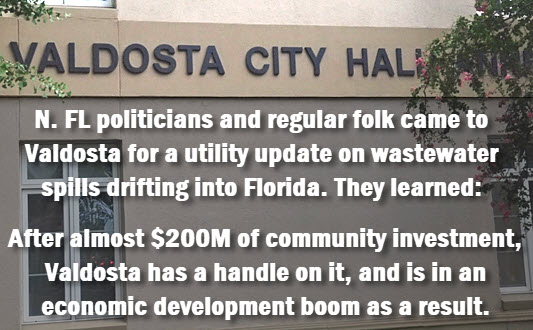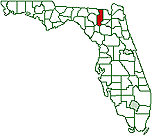N. FL's
Withlacoochee River Task Force met with
Valdosta officials on Thursday to be updated on
the formerly spill-prone Valdosta utility system
August 16, 2025 6:45 pm | 2 min read

Columbia County Observer photo and graphic
The 2-minute version (no pictures)
VALDOSTA, GA
Overview
On August 14, 2025, representatives from North Florida’s Withlacoochee River Task Force met with officials from Valdosta, Georgia, for an update on the city's ongoing efforts to improve its wastewater and sewer infrastructure. This was the first formal, in-person meeting between the Task Force and Valdosta in approximately five years. The Task Force operates under the North Central Florida Regional Planning Council (NCFRPC) and was established in 2019 in response to a series of severe sewage spills from Valdosta that had significant downstream impacts on Florida's rivers and communities.
Historical Background and Formation of the Task Force
In the years leading up to 2019, Valdosta experienced repeated multimillion-gallon sewage spills, which contaminated the Withlacoochee River and the Suwannee River in Florida. The spills were often attributed to heavy rainfall overwhelming the city's outdated infrastructure, leading to overflows that carried untreated sewage into waterways.
Recent Developments
Prior to the August 2025 meeting, there was a smaller, private session in April 2025 involving Task Force Chair Rick Davis and NCFRPC Executive Director Scott Koons with Valdosta leaders. This earlier meeting excluded key stakeholders such as John Quarterman, raising questions about transparency and inclusivity within the NCFRPC's processes. The August gathering aimed to address these gaps by providing a broader platform for discussion and updates.
Valdosta's Investments and Infrastructure Upgrades
During the meeting, Valdosta Mayor Scott Matheson and Utility Director Jason Barnes outlined the extensive measures taken to overhaul the city's water and sewer systems. Over the past 15+ years, Valdosta has invested nearly $200 million in upgrades, transforming what was once a chronically spill-prone network into a more resilient and modern infrastructure.
Economic Development
Reliable wastewater infrastructure is a foundational element for urban and industrial growth. In Valdosta's case, the improvements signal to potential investors that the city has addressed long-standing vulnerabilities, creating a stable environment for business operations.
Cleaner rivers and reduced pollution enhance the region's appeal for residential and commercial real estate.
Each dollar invested in infrastructure can yield 1.5–2 times the economic return through supply chain spending, higher wages, and local business patronage. In Valdosta, this could manifest as growth in related sectors like transportation (given its location near I-75) or education (e.g., supporting Valdosta State University by improving the city's overall livability).
Outcomes
Valdosta officials expressed confidence that the revamped system has effectively mitigated the risks of future large-scale spills, thereby reducing pollution threats to downstream Florida communities along the Withlacoochee and Suwannee Rivers. The meeting served as an opportunity for the Task Force to assess progress and discuss ongoing monitoring needs.
However, underlying concerns about transparency—stemming from the exclusionary April meeting linger, underscoring the importance of inclusive stakeholder engagement in environmental governance.
